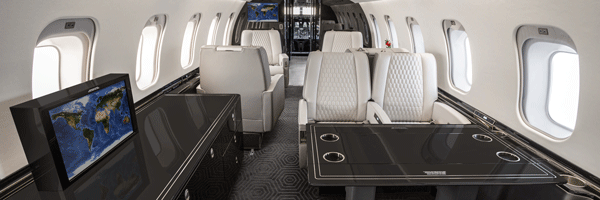An aircraft’s CMS (Cabin Management System) controls all of the powered devices in the cabin. With integrated devices, you can control in-flight entertainment, volume, lighting, and temperature throughout the cabin from your tablet (Apple or Android) or smartphone.
In this 3-part Duncan Intelligence series about CMS, we’ll cover the most common equipment requested by our customers and give you a thorough explanation of what equipment is available and how it can benefit your aircraft’s CMS.
Series Schedule
March: Cabin Displays
April: Audio Options
May: Cabin Source Equipment
For more information and greater detail, you can download the Duncan Aviation Straight Talk About CMS, here: www.DuncanAviation.aero/resources/straight-talk/cabin-management-systems

Cabin displays are the most visible components in a cabin entertainment system. Whether the intent of the cabin display is to show HD (high definition) movies or provide a moving map, the displays are the focal points.
Upgrading your cabin display can be a relatively easy way to give your cabin a facelift. It is a good option if your discretionary budget is limited, you’re planning to sell the aircraft, or your plans to refurbish the entire cabin are still a year or more away.
Display Size
The display size is an important consideration. Typically, we suggest the largest size that fits on the bulkhead space. The larger the monitor, the more structural analysis needed and the higher the costs. For this reason, it’s essential to evaluate the bulkhead to determine the most suitable and cost-effective size.
Bulkhead-mounted displays are the focal points of the cabin. The cabin appears modern and up-to-date if the displays are HD and in wide-screen format. If the displays are SD and in a square format, they stand out as dated.
Many passengers carry their own devices onto the aircraft to view their own choice of movies and other content. An increasing number of sources on the aircraft, such as moving maps and video servers, can stream content directly to smartphones and tablet PCs. They can also serve as the cabin remote control for systems, such as lighting, temperature, and entertainment.
Video Quality
There are several standards when referring to video quality. Generically, you’ll see SD (Standard Definition), HD, and now UHD (Ultra High Definition).
SD is the video standard many of us grew up watching on tube-type televisions and first-generation LCDs. They tend to look soft and blurry compared to the crisp, sharply detailed HD displays we are accustomed to today.
Most HD displays available for aircraft accept many types of content up to 1080p.
The next generation of video resolution is commonly known as UHD or 4K. The resolution quality is approximately twice that of HD displays. We’ve started to see some 4K displays certified for aircraft use.
Video is sent and received in various signal formats to achieve either SD or HD images. The format of the source video, capabilities of the display device, wiring in the aircraft, and type of connectors used all determine whether you’ll actually see HD video.
Some HD formats available today are:
Most business aircraft manufactured before 2010 cannot distribute or display HD video. A Duncan Aviation avionics expert can perform a straightforward evaluation and verify this for you.
Future Expansion
Equipment upgrades are an investment, and as with any investment, you’ll want to know if this equipment will be around for a while and if it is scalable.
Because technology changes so rapidly, we advise that you buy your equipment from a reputable, well-known OEM. As new products are introduced, a respected OEM will continue to support their older products.
Scalability, too, depends largely on the OEM. All personal electronic devices available today change rapidly and can interface with the newer CMSes. Therefore, choosing a system from an OEM that anticipates future growth and uses scalable architecture is important.
Certification
What is considered a simple plug-and-play upgrade in home or business environments is another thing entirely in an aircraft. There are regulations controlling what equipment can be installed in an aircraft and where it can be installed. Any new or upgraded piece of equipment will require some level of certification to be installed in an aircraft.
As an experienced installation facility, Duncan Aviation will ensure that only properly certified equipment is installed with a successful Return-to-Service path accepted by the FAA and other aviation authorities worldwide.
For more information and greater detail, you can download the Duncan Aviation Straight Talk About CMS, here: www.DuncanAviation.aero/resources/straight-talk/cabin-management-systems
January 2026
January 2026
January 2026
January 2026
December 2025